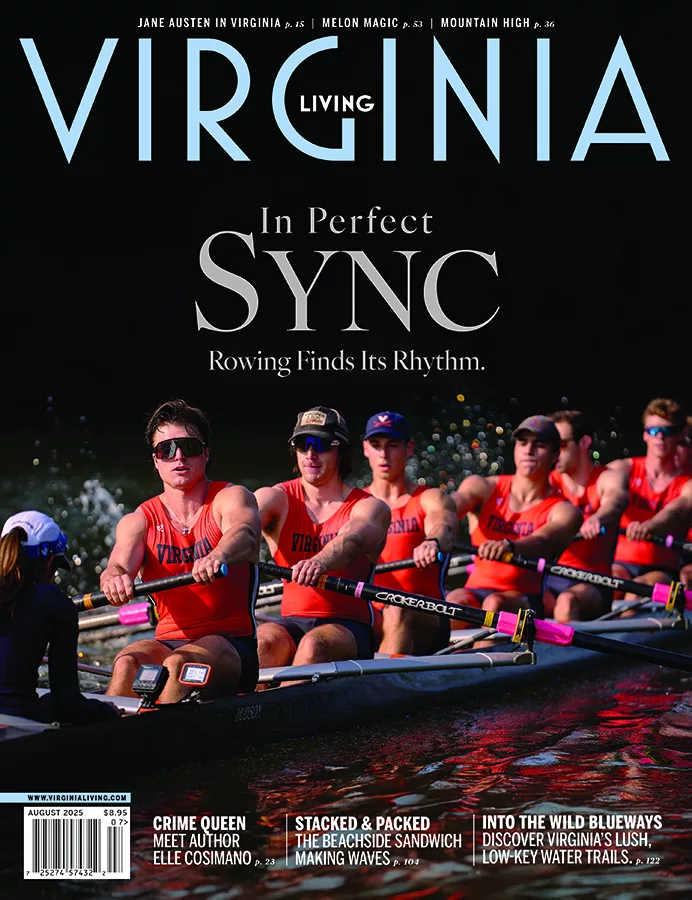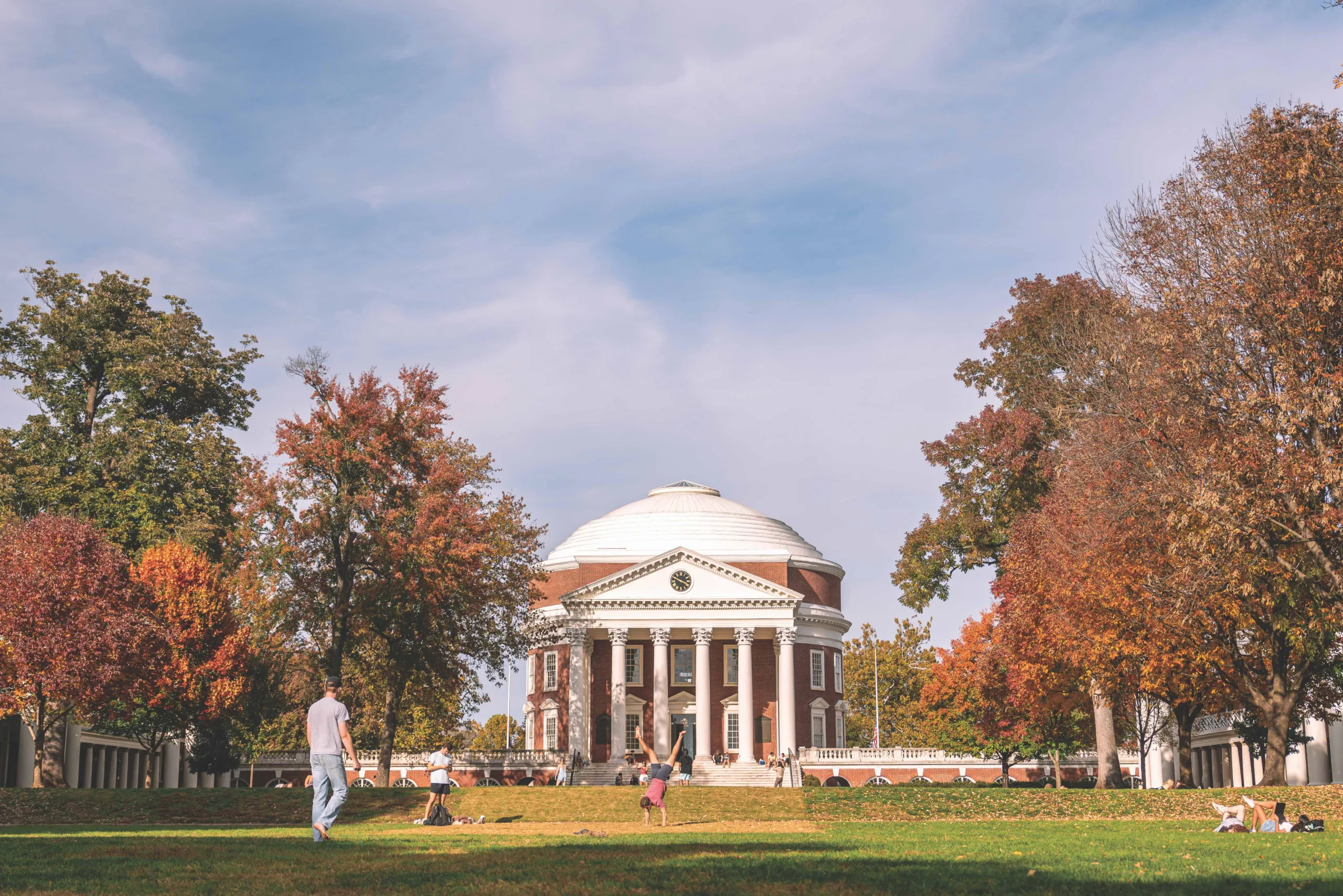The Virginia Chapter of The Nature Conservancy, now 50 years old, is a front-line group that works to protect natural resources and wildlife habitat by buying land and managing its 60 preserves.

Call of the Wild

Call of the Wild
Fletcher Smith and Libby Mojica, of the Center for Conservation Biology, pull a rocket-fired bird trap out of the marsh.

Call of the Wild
Mojica sets up a firing pin about 250 yards from the trap.

Call of the Wild
On a sparkling August morning on the Atlantic side of the Eastern Shore, at an end-of-road spot called Box Hill in Machipongo, Virginia, research biologists Libby Mojica and Fletcher Smith, along with colleague Bart Paxton, are doing the hard work that is conservation. The three are from the Center for Conservation Biology at the College of William & Mary, and on this day—working in tandem with Barry Truitt of The Nature Conservancy—they have spent more than an hour deploying three rocket-fired bird-netting traps on marsh mudflats alongside a creek where shorebirds like to gather as the tide comes in. The researchers haul the traps to separate spots in the marsh by boat, cover each with grass and then, sloshing through water and mud, run wire for each about 250 yards to firing pins hung from stakes.
Their target is the whimbrel, a highly migratory shorebird that spends the spring and, for some, part of the summer, on the Eastern Shore, fattening up on fiddler crabs before setting off on a long, nonstop journey to its breeding grounds in the Hudson Bay or Northwest Territories of Canada. Later, the whimbrel—distinctively brown, with a downward curving beak that’s ideal for plucking crabs out of burrows—will head south to its prime wintering habitat at the mouth of the Amazon River in northeastern Brazil. These are birds that fly massive distances—hundreds of thousands of miles—every year.
However, recent surveys on the Eastern Shore indicate that the whimbrel population has fallen since the mid-1990s, perhaps by as much as half. Experts don’t know why, though one theory is that climate change in the Arctic has altered their food supply. The CCB researchers have been catching and tagging whimbrels, attaching tiny, solar-powered transmitters to their backs, to monitor their migration patterns. Catching any bird is not easy, but on this day, unlike the day before when a prematurely strong high tide scuttled the effort, the team gets lucky.
Peering through a scope, Truitt, chief conservation scientist for TNC and the Virginia Coast Reserve, spots three whimbrels preening on a mudflat directly in front of one of the traps. Using a radio, he alerts the CCB researchers. Mojica hurries over to a firing pin, while Fletcher moves to a position where he can see the birds with binoculars. Confirming that the birds are in a favorable spot, he tells Mojica, via radio, to get ready: “Three, two, one, now!” Boom! Three projectiles hurl the net forward, nabbing two of the whimbrels. Moments later Paxton is on his knees in the muck, untangling the birds from the netting. The birds are then taken to a van on shore where Mojica and Fletcher weigh and measure them. One of the birds, weighing about a pound, is deemed stout enough to receive a $3,500 satellite tag. He is named Goshen, after a big neck of land nearby, and then released with his buddy—whereupon the two birds flap away at top speed, eager to rejoin their friends. “It’s taken a tremendous effort,” says Truitt, “but we’ve caught 100 whimbrels over the last three years,” and put satellite tags on 16 of them—the better to study their lives.
The whimbrel tagging project is one of numerous, statewide conservation initiatives that The Nature Conservancy’s Virginia chapter is involved with practically every day. This year marks the 50th anniversary of the chapter, which owes its start primarily to the efforts of three conservation-minded people in Richmond—the late Elizabeth Scott Bocock (a prominent preservationist), FitzGerald “Gerry” Bemiss (a former state senator) and George Freeman Jr. (an attorney). According to Mr. Freeman, 81, the genesis was a meeting between Mrs. Bocock and Richard Pough, then national head of TNC, in 1960. Pough came to Richmond and met with Bocock—and she, in turn, pulled in Bemiss, Freeman and others. “We told them,” says Freeman, “that we’d do all we could to organize a [local] chapter. Six months later, we had a much bigger meeting at Mrs. Bocock’s house—and that’s when the chapter was officially organized.” The initial effort involved raising money to create a preserve on Wildcat Mountain in Fauquier County. Mary Buford Hitz, a daughter of Mrs. Bocock, says, “My mother was a very strong environmentalist in the 1940s and 1950s, long before it was popular. I imagine that Gerry came to her and said, ‘Can you help me with this,’ and she would have said, ‘Yes, indeed.’”
Since those early days, the Virginia chapter has expanded significantly. It now has several offices around the state and about 60 employees, nearly all of whom are on the ground doing work aimed at wildlife habitat restoration and enhancement, land and water protection, education and outreach—in mountain forests, in rivers and along the coastline. “Over the course of our 50 years,” says Mark Lipford, a biologist and executive director of TNC’s Virginia chapter, “We’ve protected more than 300,000 acres of land in Virginia.” In particular, he notes, the organization has played a key role in the creation of laws establishing conservation easements, so that private landowners can conserve their property in perpetuity. Says Lipford: “In 1999, we provided leadership for a conservation easement tax credit that is the most lucrative of any state in the country. It has helped a lot of land conservation take place.” In 2002, he adds, TNC helped pass another law that allowed landowners to broker an easement on the open market, if they couldn’t take full advantage of it.
Jon Schwedler, a senior media manager for TNC, says that without the work of his organization, “the Commonwealth would be a different place.” By that he means there would be even more development of the type that has turned enormous swaths of rural America into shopping centers and subdivisions, resulting in less wildlife habitat and lots more pressure on animals. According to Lipford, Virginia loses 50,000 acres of forest and farmland annually, primarily to development. TNC, through innovative land-acquisition deals and partnerships with various state and federal agencies, aims to protect what Lipford calls “strategic areas.” He adds: “We are really an organization that is non-confrontational and based on science. We try to work with people, including developers, business and industry, to get as much done as possible.” The Virginia chapter, considered one of the strongest TNC state organizations in America, gets a lot done on the 60 preserves it owns and manages.
One of the organization’s major initiatives in southwestern Virginia has been to protect the Clinch River watershed. It is the nation’s most important in terms of rare and imperiled fish and fresh-water mussels. The watershed harbors 19 rare fish species and 40 varieties of freshwater mussels, which Schwedler calls “the aquatic equivalent of canaries in a coal mine because they are good indicators of water quality.”
The analogy is ironic, given that the Clinch and Powell River watershed is in fact threatened by coal mining. Since 1990, TNC has been working to protect the Clinch Valley’s land, water and wildlife from what it calls “incompatible practices related to agriculture, development, timber harvesting and energy development.” The organization has helped to protect 35,000 acres of natural habitat in the valley—including seven shoals that are a key home for mussels. Largely because of TNC’s efforts, and the fact that the organization owns land around Cleveland Island in the Clinch River, fresh-water mussels are said by TNC officials to be “holding their own.”
Two years ago, working with the Virginia Department of Game and Inland Fisheries, the U.S. Fish and Wildlife Service, business interests and academics, TNC helped to launch the Clinch-Powell Clean Rivers Initiative to improve water quality and river health in the region. One aim is to gather data on fresh-water mussels that can be incorporated into the enforcement process for the federal Clean Water Act. The Clinch River is not just a home for wildlife, says Schwedler; it also supplies drinking water for people, and so “is vital for human health.”
In southeastern Virginia, particularly in Sussex County, the TNC owns the 2,200 acre Piney Grove Preserve. There, as part of its Southern Rivers Program, the environmental group is working to bring back the longleaf pine tree—which gradually has been supplanted by the loblolly pine—and along with it, the state’s rarest bird, the endangered red cockaded woodpecker. It is a peculiar (and beautiful) bird that prefers to live in longleaf pines that are at least 80 years old. The Nature Conservancy, using select forest burns, is thinning out the loblolly and working to create a savannah in which longleaf pine trees can thrive. So far, so good: Lipford says that the red cockaded woodpecker restoration is “going very well,” adding, “There were only a handful of the birds when we started there in 1999…and now we have a self-sustaining population.”
The Nature Conservancy deserves credit for least two other achievements in southeastern Virginia. First, it has effected the most successful reestablishment of bobwhite quail in the state. Second, in the 1970s, it acquired nearly 50,000 acres of land in the Great Dismal Swamp from the Union Carbide Corp.—the largest corporate donation ever to TNC’s Virginia chapter. The environmental group then handed the land over to the U.S. Fish and Wildlife Service, which turned it into a National Wildlife Refuge. “We are an intermediary for a lot of conservation work,” explains Lipford. “It’s all about getting the job done.”
Buying land is always a TNC priority. The organization, often in cooperation with state agencies, identifies area of biological importance—and then when land-buying opportunities arise, it swings into action. TNC will go out and raise money—privately—to make a purchase. Last March TNC bought 13,500 acres of ecologically significant forestland from a private timber company within the Dragon Run and Mattaponi watershed, not far from the Chesapeake Bay. The Nature Conservancy raised $12 million to buy the land, then sold it to another timber company that will use it in what Schwedler says is “an environmentally friendly way.” Before selling the property, TNC put a conservation easement on it that will protect it indefinitely.
“We sold the land for less than we paid,” says Schwedler, “but the value for us is knowing that we protected it biologically.” Adds Lipford: “Had we not stepped in, we might have lost that land to development. As companies sell their land, we try to be strategic, buying puzzle pieces and establishing big blocks of land on the landscape.”
One critical conservation area is Virginia’s Eastern Shore. In four Barrier Island bays on the Atlantic side of the shore, TNC’s Virginia Coast Reserve is engaged in the world’s largest and most successful restoration of eelgrass (or seagrass)—and is also working to create new oyster reefs. (Virginia has 18 barrier islands, and TNC owns all or part of 14 of them.) Truitt says that marine restoration has become a new and important point of emphasis for his group.
Eelgrass, a crucial nursing habitat for finfish, crabs and bay scallops, disappeared from the Barrier Island bays in the 1920s—wiped out by disease and hurricanes—and with it went the bay scallops. Over the last couple of years, using $2.2 million of federal stimulus money, the Virginia Coast Reserve, with the help of volunteers, has collected millions of eelgrass seeds, cured them for six weeks, then planted them in one-acre plots. “We planted 45 acres last year,” says Truitt, “and are due to plant 55 acres this year. We want to plant about 60 acres a year for 10 years. That 600 acres could grow to 10,000 or more acres, we’re hoping, and eventually become self-producing.” Meanwhile, TNC is doing research on how best to reintroduce bay scallops into the eelgrass restoration areas.
Truittt, 62, has worked for TNC on the Eastern Shore for 34 years. For a long time, he was a one-man band; now, he’s got three biologists working for him at the Coast Reserve, trying to protect what he calls “the Yellowstone Park of breeding and migratory shorebirds—it is a globally important area.”
One of Truitt’s colleagues, Alexandra Wilke, has spent seven years tagging oystercatchers, a handsome, orange-peaked shore bird that is not threatened or endangered but, says the 33-year-old biologist, is a very good “indicator species,” meaning its behavior and health offers good insight into the well-being of the overall shorebird population. Since 2003, she and colleagues have tagged more than 700 oystercatchers.
I went out one night with Wilke and three others—Ruth Boetcher of the Virginia Department of Game and Inland Fisheries, Connor Coleman, a TNC technician, and Mike Byrd, a technician with the Department of Game and Inland Fisheries—on a tagging operation. Using a flat-bottom workboat, we left the Gargatha boat ramp (an hour north of Cape Charles) at dusk. Our destination was a barrier island named Metompkin—a flat, seven-mile-long strip of land that’s a popular nesting area for oystercatchers. Boetcher and Byrd dropped Wilke, Coleman and me off at the southern end of the island—with long-handled nets, headlamps, and tagging gear—and then proceeded to the north end. The idea was for each group to walk along the ocean side and meet close to the middle. We waited for 40 minutes or so until it got completely dark. It was windy, but we could not have ordered a more perfect night—above us a vast canopy of stars, a thin crescent of moon—and it was the last night of the Perseid meteor shower.
With the Milky Way strung out overhead, we started trekking along the shore as the tide roared in. Wilke held a spotlight and used it to scan the wide beach for birds. When oystercatchers are caught in a spotlight they can sometimes be mesmerized long enough to be captured. Sometimes.
As any conservationist will tell you, the elements often wreck the most prudent of plans. During an hour of walking over sand and surf, we saw no oystercatchers. Wilke surmised that the hard wind had pushed the birds to other locations. Once, the three of us went charging after a bird, then stopped suddenly at Wilke’s command. Turns out it was a willet, not an oystercatcher. Then, after another hour, there was a flurry of activity: Wilke twice spotted a pair of oystercatchers on the high side of the beach; we went racing across the sand in the dark, but they eluded our nets.
Then came a third oystercatcher sighting. Wilke trained her light on a bird, Coleman dashed 15 yards and deftly dropped his net over the flummoxed creature. We got one! And then, before we could even enjoy a moment of weary satisfaction, he noticed that the bird had already been tagged. “What are the odds?” said Wilke.
After another hour of walking on Metompkin, we came to the end of our wet, sandy hike. It was around midnight, and we’d walked about three and half miles. We slogged through water and marsh grass to get to the boat, and then made our way along the creek to pick up the others, who had even less luck than we did. It had been a bad night for tagging birds, but an exhilarating night otherwise on a windswept barrier island. And Wilke was already planning her next tagging expedition.
That is the reality of conservation work: There is always more to do. Most projects are long and labor intensive. And, of course, they require money. “A lot of our goals rest with money,” says Lipford. Indeed, 90 percent of the organization’s funding comes from private donations. The remaining 10 percent is split between corporate and government monies. “We have the ability to run fundraising campaigns around big land projects,” says Lipford.
In his view, “the majority of the public is sympathetic to conservation.” He notes that TNC has had two general obligation bond referendums to provide funding for natural areas, and they each passed with 67 percent of the vote. Still, he adds, “a lot of Americans tend to take for granted the benefits provided by a healthy environment—clean air and clean water. We need to do a better job of educating the public about the benefits of land and water conservation—which keep the planet healthy.”
Development cannot be stopped, he acknowledges, “but we have to be smarter about how we develop.” In practice that means that “hard” infrastructure development (roads and utilities) must be accompanied by green infrastructure plans for livable communities. That, says the TNC executive director, “will continue to be a challenge.”
His medium term goal is not surprising—to buy more land, in some cases adding “puzzle pieces” to existing TNC preserves. “There are [places] we worry about, and being able to connect them to existing conservation corridors will help protect Virginia’s biodiversity.” As Schwedler puts it, “We want nature to leave a big footprint in the Commonwealth.”









